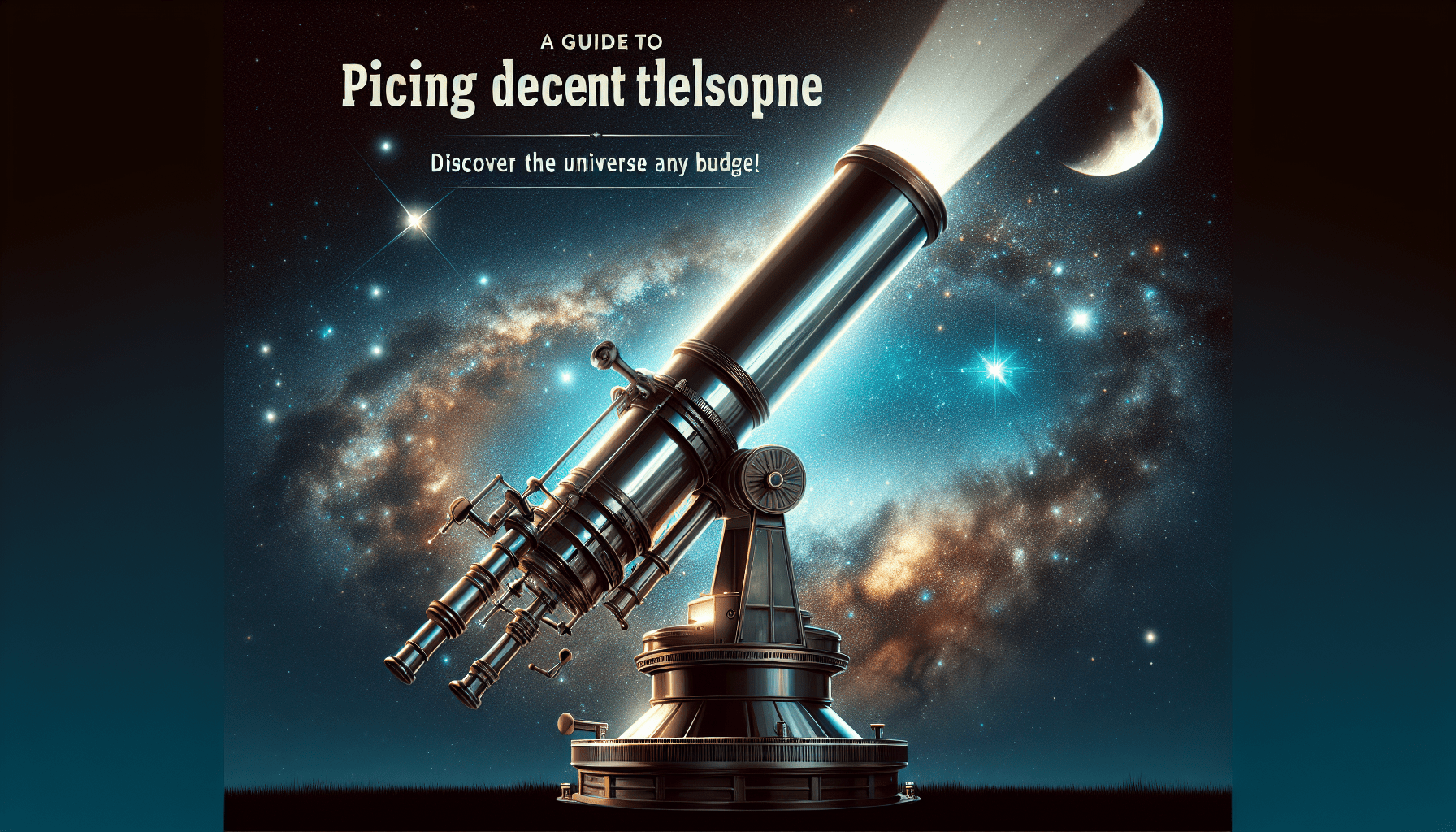A Guide to Pricing Decent Telescopes. In the vast expanse of the night sky, the wonders of the universe beckon stargazers across the globe, igniting a curiosity that cannot be quelled. Yet, for those embarking on the journey of exploring the cosmos, a key question emerges: How much should one pay for a decent telescope? In this comprehensive guide, readers will delve into the intricacies of pricing telescopes, navigating through an array of factors that contribute to their monetary value. From the quality of optics to the sophistication of features, this article unravels the enigma surrounding the pricing of telescopes, equipping aspiring astronomers with the knowledge needed to discover the right investment for their celestial pursuits.
Table of Contents
Understanding Telescope Pricing

Factors Affecting Telescope Prices
Telescope prices can vary significantly depending on various factors. The key factors that affect telescope prices include the type and quality of the telescope, the brand reputation, the level of craftsmanship, and the included accessories. Generally, telescopes with better optics, superior materials, and advanced features tend to be priced higher. Additionally, well-known brands often come with a premium price tag due to their reputation for producing reliable and high-quality telescopes. It is essential for prospective buyers to understand these factors before making a purchasing decision.
Budget Considerations
When considering the purchase of a telescope, it is essential to establish a budget. Determining the maximum amount you are willing to spend will help narrow down the options and prevent overspending. It is crucial to find a balance between price and quality. While it may be tempting to go for the cheapest option available, it is important to remember that investing in a higher-quality telescope will provide better performance and longevity.
Quality vs. Price
The adage “you get what you pay for” rings true in the world of telescopes. Higher-priced telescopes often offer superior quality, better optics, and enhanced performance. However, this does not mean that all expensive telescopes are automatically better than their more affordable counterparts. It is essential to consider the specific needs and requirements of the user. Sometimes, a mid-range or even an entry-level telescope can provide satisfactory performance for beginners or casual stargazers.
Researching Telescope Brands
Thorough research plays a vital role in selecting an appropriate telescope. It is important to familiarize oneself with the various brands available in the market. Established brands with a long history of producing quality telescopes often have a solid reputation for a reason. By reading reviews, consulting astronomy forums, and seeking recommendations from experienced astronomers, prospective buyers can gain insights into the performance, durability, and customer satisfaction associated with different telescope brands. Taking the time to conduct proper research can greatly assist in making an informed purchasing decision.
Types of Telescopes
There are three main types of telescopes commonly used by astronomers: reflector telescopes, refractor telescopes, and compound telescopes. Each type has its own advantages and is suitable for different observing purposes.
A Guide to Pricing Decent Telescopes
Reflector Telescopes
Reflector telescopes, also known as Newtonian telescopes, utilize a large curved mirror to gather and focus incoming light. One of the key advantages of reflector telescopes is their ability to provide a large aperture at an affordable price point. This larger aperture allows for better light-gathering capabilities and enables observers to capture fainter objects in the night sky. Reflector telescopes are especially popular among amateur astronomers and those interested in deep-sky observations.
Refractor Telescopes
Refractor telescopes, on the other hand, use lenses to gather and focus light. These telescopes are known for their crisp, high-contrast images and are often preferred for lunar, planetary, and terrestrial observations. Refractor telescopes are typically more expensive than reflector telescopes of similar aperture due to the precision required in their lens design and construction. They are well-suited for those who prioritize image quality and are willing to invest in a higher-end telescope.
Compound Telescopes
Compound telescopes, also referred to as catadioptric telescopes, combine both mirrors and lenses to achieve their optical design. The most common types of compound telescopes are Schmidt-Cassegrain and Maksutov-Cassegrain telescopes. These telescopes offer a compact and versatile design, making them popular among astronomers who prioritize portability and convenience. Compound telescopes are often more expensive than entry-level reflector or refractor telescopes due to their complex optical systems and compact designs.
Entry-Level Telescopes
For beginners who are just starting their journey into astronomy, entry-level telescopes provide an affordable and accessible option to explore the night sky. These telescopes are designed with simplicity and ease of use in mind, making them suitable for newcomers to the hobby.
Affordable Options
Entry-level telescopes are available in a wide range of price points, making them accessible to individuals with various budgets. While it is possible to find inexpensive telescopes, it is important to strike a balance between affordability and quality. Investing in a reputable brand and opting for a telescope with decent optics will ensure a better observing experience and increase the chances of a longer-lasting instrument.

Considerations for Beginners
When choosing an entry-level telescope, beginners should consider factors such as ease of setup and portability. Telescopes that are lightweight and easy to assemble are ideal for those who are new to astronomy. Additionally, telescopes with simple controls and intuitive interfaces can help beginners quickly grasp the basics of telescope operation and navigate the night sky more effectively.
Features to Look for
Entry-level telescopes often come with a range of features that can enhance the observing experience. Some desirable features include a stable and sturdy mount, smooth and precise manual controls for tracking celestial objects, and easily interchangeable eyepieces for adjusting magnification. It is important to research and compare different models to find the telescope that best suits the specific needs and interests of the beginner astronomer.
Intermediate-Level Telescopes
Intermediate-level telescopes offer improved optics and performance compared to entry-level models. They are suitable for enthusiasts who have gained some experience in using telescopes and are looking to further explore the wonders of the night sky.
Better Optics and Performance
Intermediate-level telescopes often feature larger apertures and higher-quality optics, resulting in sharper and more detailed views of celestial objects. These telescopes can provide enhanced views of planets, galaxies, and nebulae, allowing intermediate-level users to delve deeper into their observations and pursue more challenging targets.
Advanced Features
Beyond improved optics, intermediate-level telescopes often come equipped with advanced features such as motorized mounts, computerized tracking systems, and built-in GoTo functionality. These features automate the process of finding and tracking celestial objects, reducing the time and effort required for precise positioning. Intermediate-level telescopes with advanced features provide a stepping stone towards more professional-level observing.

Suitable for More Experienced Users
Intermediate-level telescopes cater to the needs of astronomers who have developed a solid foundation in telescope operation and are ready to tackle more advanced observing techniques. These telescopes strike a balance between affordability and performance, providing a rewarding experience for dedicated stargazers who are eager to expand their knowledge and skills.
High-End Telescopes
High-end telescopes represent the pinnacle of optical performance and craftsmanship. These telescopes are designed for serious astronomers who demand the best possible views of the cosmos and are willing to invest in premium instruments.
Superior Optics and Performance
High-end telescopes feature state-of-the-art optics and precision engineering, resulting in unparalleled image quality and clarity. These telescopes often utilize exotic glass types and advanced coatings to minimize aberrations and maximize light transmission, providing breathtaking views of celestial objects. The main advantage of high-end telescopes lies in their ability to capture fine details and subtle nuances in astronomical phenomena.
Premium Materials and Craftsmanship
In addition to exceptional optics, high-end telescopes are constructed using premium materials and exhibit superior craftsmanship. These telescopes are typically made from high-quality metals, such as machined aluminum or carbon fiber, which provide strength, stability, and vibration dampening. The attention to detail and precision during the manufacturing process ensure that every component of the telescope functions flawlessly.
Advanced Astrophotography Capabilities
High-end telescopes often feature robust astrophotography capabilities, enabling astronomers to capture stunning images of the night sky. These telescopes are equipped with specialized accessories and attachments that allow for precise camera mounting and tracking. High-end telescopes provide the necessary tools and flexibility for astronomers to engage in deep-sky astrophotography, capturing distant galaxies, nebulae, and star clusters in exquisite detail.
Telescope Accessories
Telescope accessories complement the main instrument and can greatly enhance the observing experience. From eyepieces to filters, various accessories are available to help astronomers customize their telescope setup according to their specific preferences and observing goals.

Eyepieces and Barlow Lenses
Eyepieces are essential accessories for telescopes as they determine the magnification and field of view. Investing in a range of eyepieces with different focal lengths allows for versatility and the ability to tailor the view to specific objects. Barlow lenses, on the other hand, can double or triple the effective focal length of an eyepiece, significantly increasing magnification.
Finderscopes and Red Dot Finders
Finderscopes and red dot finders assist astronomers in accurately locating celestial objects. Finderscopes are small telescopes mounted alongside the main telescope, providing a wider field of view for locating objects. Red dot finders, on the other hand, project a red dot onto a transparent screen, allowing users to align the dot with their desired target in the night sky.
Mounts and Tripods
Stable and sturdy mounts are crucial for smooth and controlled movements of the telescope. Equipping the telescope with a solid mount ensures minimal vibrations and enables precise tracking of celestial objects. Tripods, often made of aluminum or carbon fiber, provide a stable platform for the mount and telescope, allowing for comfortable observing sessions.
Filters and Filter Wheels
Filters help to enhance and refine the views of specific celestial objects by selectively blocking certain wavelengths of light. Filters can be used to enhance contrast, reduce glare, or isolate particular features of an object. Filter wheels, which hold multiple filters, allow for seamless switching between different filters without disassembling the telescope setup.
Telescope Buying Considerations
When purchasing a telescope, several important considerations should be taken into account to ensure a satisfying and fulfilling observing experience.

Aperture Size and Light Gathering
Aperture size plays a crucial role in a telescope’s light-gathering capabilities. The larger the aperture, the greater the amount of light the telescope collects, resulting in brighter and clearer views. A larger aperture also allows for the observation of fainter objects, making it an essential consideration for those interested in deep-sky observation.
Focal Length and Magnification
The focal length of a telescope determines its magnification potential. A longer focal length generally provides higher magnification, which is ideal for planetary or lunar observations. However, it is important to keep in mind that excessively high magnification can result in dimmer views. Finding the right balance between magnification and image brightness is crucial for optimal observing experiences.
Mount Stability and Control
A stable mount is essential for smooth and controlled movements of the telescope. A sturdy mount minimizes vibrations, allowing for clear and crisp views of celestial objects. Additionally, the type of mount chosen, whether it be an equatorial or altazimuth mount, affects the level of control and tracking precision.
Portability and Setup
Consideration should be given to the portability of the telescope, especially for those interested in taking their observing sessions to different locations. Telescopes that are lightweight and easy to transport enable observers to explore various observation sites and provide greater flexibility in choosing suitable viewing conditions.
Maintenance and Upgrade Options
Understanding the maintenance requirements of a telescope is important, as it ensures the longevity and optimal performance of the instrument. Additionally, considering the availability of upgrade options is beneficial for those who plan to expand their observing capabilities over time. It is advisable to choose a telescope that can accommodate future accessories or advancements in technology.
Used Telescopes vs. New Telescopes
Prospective telescope buyers often face the dilemma of choosing between a new telescope or a used one. There are advantages and disadvantages to both options, and it is important to carefully consider each before making a decision.
Pros and Cons of Buying Used
One of the main advantages of buying a used telescope is the potential cost savings. Used telescopes are often priced lower than their brand-new counterparts, allowing buyers to acquire a higher-quality instrument for their budget. Additionally, buying used can provide access to discontinued or vintage telescope models that may no longer be available new.
However, there are risks associated with purchasing a used telescope. Used telescopes may have undergone wear and tear, potentially affecting their performance and optical condition. It is crucial to thoroughly inspect and assess the condition of a used telescope before making a purchase, or preferably, seek the advice of experts and experienced astronomers.
Where to Find Used Telescopes
There are several avenues for finding used telescopes. Online marketplaces, such as auction websites and classified ads platforms, often have listings for used telescopes. Astronomy forums and local astronomy clubs may provide opportunities to connect with individuals selling their telescopes. Additionally, specialized astronomy retailers sometimes offer used telescopes for sale, providing a more reliable source compared to private sellers.
Tips for Buying Used Telescopes
When considering the purchase of a used telescope, there are several tips that can help ensure a successful transaction. Firstly, it is recommended to research the specific model and its typical market value to verify the pricing of the used telescope. Secondly, thoroughly examine the telescope’s condition, paying attention to the optics, mount, and accessories. Lastly, if possible, request a demonstration or test viewing to assess the overall performance and suitability of the telescope.
Warranty and Customer Support
The availability of a warranty and reliable customer support is a crucial consideration when purchasing a telescope. Investing in a telescope with a reputable manufacturer’s warranty provides peace of mind and serves as a safeguard against potential defects or malfunctions.
Importance of Warranty
Telescopes, like any other complex instrument, can occasionally experience issues or require repairs. A warranty ensures that customers receive support and necessary repairs or replacements in the event of a genuine problem. It is advisable to carefully review the warranty terms and conditions to understand the coverage period and what is included.
Manufacturer’s Support
Reputable telescope manufacturers often provide reliable customer support and assistance to customers. From troubleshooting guidance to expert advice, the manufacturer’s support can be invaluable in resolving any issues or providing recommendations.
Extended Warranty Options
Some telescope retailers offer extended warranty options for additional coverage beyond the standard manufacturer’s warranty. While these extended warranties may have associated costs, they provide an extended period of protection and peace of mind. Prospective buyers should carefully evaluate the value and benefits of extended warranties before making a decision.
Conclusion
Selecting the right telescope involves considering various factors, such as budget, intended use, and personal preferences. Understanding the factors that influence telescope prices and the differences between different telescope types and models is crucial when making an informed decision. Finding the right balance between price and quality is essential, as it ensures a rewarding and long-term hobby. By considering factors such as apertures, focal lengths, mount stability, and portability, aspiring astronomers can align their expectations and needs with available telescope options. Whether starting with an entry-level telescope or investing in a high-end instrument, the world of astronomy awaits those who dare to explore the universe above.
Related site – How Much Does a Good Telescope Cost?
